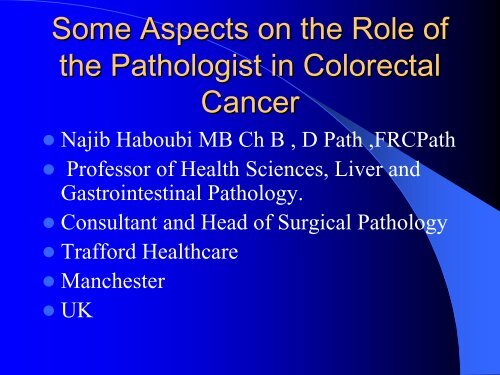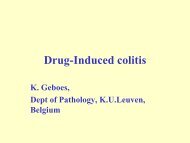Najib Haboubi
Najib Haboubi
Najib Haboubi
Create successful ePaper yourself
Turn your PDF publications into a flip-book with our unique Google optimized e-Paper software.
Some Aspects on the Role ofthe Pathologist in ColorectalCancer• <strong>Najib</strong> <strong>Haboubi</strong> MB Ch B , D Path ,FRCPath• Professor of Health Sciences, Liver andGastrointestinal Pathology.• Consultant and Head of Surgical Pathology• Trafford Healthcare• Manchester• UK
Background• In USA(280m) there are 150,000new cases and 60,000 deaths per annum.• In UK (60m) there are 35,000 newcases and 16,000 deaths per annum.• New patterns in some parts of the world.• In India 6 th commonest among female and9 th amongst male.
Accurate Pathological• Confirm diagnosis.• Inform prognosis.Reporting• Plan treatment of individual patients.• Audit pathology services.• Evaluate and audit the quality of other serviceslike radiology, surgery and oncology.• Collect accurate data for cancer registrationand epidemiology.• Facilitate high quality research.•Plan service delivery.
Multi Disciplinary Team (MDT)• Colorectal Surgeons• Hepatobiliary(Thoracic) Surgeons.• Radiologists.• Surgical Pathologists.• Medical Oncologists.• Gastroenterlogists• Specialist Nurse.• Stoma Nurse.• Clinical geneticist /counsellor.• Social worker.• Clinical trials coordinatoror research nurse.• GP• Dietician
MDT• Takes place at regular intervals• Encourages a more efficient and teamworking atmosphere .• Have a consensus approach to treatmentaccording to agreed protocols.• Quick and appropriate referral pattern.• Audit surgical treatment.• Audit pathology reports.
EvidenceBased
Second Edition•2007•Few important additions.•www.rcpath.org
Assessmentof RM• Longitudinal• Circumferential / lateral /Radial / nonperitonealised resection margin.
Minimum safe Longitudinal• 5• 3• 2• 1• < 1cmMargin
Reappraisal of 5 cm rule ofdistal excision forcarcinoma of rectum• Williams , Dixon and Johnston.Br.J.Surgery 1983
Conclusion• The application of the 5 cm rule of distalexcision may cause patients with low rectalcancer to lose their anal sphincterunnecessarily.
Kirwan , Drumm, Hogan,Keohane• Determining safe margin of resection in lowanterior resection for rectal cancer.Br.J.Surg 1988•1cm
Declining indication for APRresection in favour of AR• Kirwan , O’Riordain and Waldron…..• Br.J.Surg 1989
Karanjia, Schache, North andHeald• ‘Close shave’ in anterior resection.• Br.J.Surg. 1990• 1cm
Conclusion• Reduction of resection margins (providedTME and washout is properly performed)does not increase local recurrence orcompromise survival.
Additions in the 2 nd edition(1)• Documentation type of procedure .• For rectal cancer, it is expected to havemore AP than APR .
Audit• AR 1670• APR 746• Hartman’s 299• There is a trend of increase the AR over APRdue to:• Better preoperative treatment• Better imaging modalities and• Better surgery.Good surgeons should be able toundertake AR for tumours above 5cm from analverge.
Circumferential (CRM)/ Lateral / Radial / NonPeritonealisedResection Margin(NPRM)
Circumferential resectionmargin Involvement (CRMI)1mm or less• High Local Recurrence.• Low Survival.• Poor Standard of Surgery.• Aggressive Disease.• Tumour Location.• Male gender.
Addition to the 2 nd edition(2)• Grading of surgical plane of resection inrectal cancer.• The continuous feedback to surgeonsmay lead to improve quality of surgery.
Macroscopic Evaluation ofRectal cancer ResectionSpecimens• Clinical Significance of the Pathologist inQuality Control.• 2 years follow up.• Iris Nagtegaal et al• J Clin Oncol 2002, 20: 1729-1734
Macroscopic Grading ofTME• A (3) ( Good). Complete. Smooth, noconing, defect >5 mm and regular CRM• C (1) ( Poor). Defects down to theMuscularis ,conning, no bulk and irregularCRM• B(2) .Nearly complete. Defect present butMuscularis is not apparent(except at theinsertion of LA) and irregular CRM.
ResultsGrade A&B -C- Poorgood andacceptableLocalRecurrenceLocal recurrenceand DistantMetastasis8.7% 15%20.3% 36.1%2 Year Survival 90.5% 76.9%
Addition to the 2 nd edition(3)• Measurement of tumour beyond the muscularispropria recorded in mm.• This is to:a/ facilitate audit of preoperative imaging ofextramural spread as it is of importance inselecting patients of rectal cancer to choose atherapy arm .b/ It has a prognostic implication for rectal cancer.5mm or more is associated with adverse prognosis.
Addition to the 2 nd edition(4)• Recording tumour involvement of theNPRM in colonic tumours (in addition torectum) like the caecum. These patientsmay be selected for post operative adjuvanttherapy.• Bateman et al J Clin Path 2005 and Quirkeet al 2006 J Path
Addition to the 2 nd edition(5)• Recording serosal ( peritonealsurface) involvement.• ‘Tumour cells visible either on theperitoneal surface or free in theperitoneal cavity carry badprognosis’
Influence of local peritonealinvolvement on pelvicrecurrence and prognosis inrectal cancer.Shepherd, Baxter and LoveJ. Clin. Path 1995
Local Peritoneal Involvement1. Detected in 25.8% (54/209) of cases.2. Showed considerable prognosticdisadvantage in curative and non curativecases.3. May be an important factor in localrecurrence of upper rectalcancers.
The Prognostic Importance ofPeritoneal Involvement inColonic Cancer: aProspective Evaluation• Shepherd et al Gastroenterology 1997• Strong predictive value for local recurrence/ persistent disease specially when there ismucinous differentiation.
Additions in the 2 nd edition(6)•Recording of marked orcomplete tumour regression inpatients with rectal cancer thathave received adjuvant chemo /radiotherapy (CRT)
1895XRT 1 stused
BMJ 1897
For Rectal cancer• Preoperative Chemoradiotherapy (CRT)is considered for T2-T3 / T4
Rationale for adjuvantCRT for Rectal Cancer• Increases tissue sensitivity towardsradiation.• Radiation stops proliferation.• Significant decrease in loco-regionalrecurrence AND overall survival.
Irradiation ofTumour Zone•Tumour Tissue.•Adjacent ‘normal’ tissue.
TARGET•DNADIRECTINDIRECT•CYTOPLASM
CELL CYCLE• GO• G1• G2• S•M
Because different cells havedifferent cell cycles•Rapidly dividing cells are•MoreChemoradiosensitive
Turn over of cells in the gut•Epithelial cells•Endothelial•Stromal
Radiatiotherapy•Short Course• 25Gys over 5 days in5-10 fraction with thelast fraction within 72hours before surgery.• Early stage.• Not well patients.•Long Course• 45-50 Gys over 5 weeksfollowed by surgery afterat least 3 weeks from thelast dose.• Tethered ,T3 and T4.• Large.• Anterior location
Short term preoperative radiotherapy interfereswith the determination of pathologicalparameters in rectal cancer• Iris Nagtegaal et al. J Path 2002,197:20-27.1306 patients(706 TME alone, 598 TME+RT)• Decrease in T lymphocytes and neutrophils.• Increase in fibroblasts.• Decrease in no. of LN retrieval but not in +velymph nodes.• No change in depth.• Three folds decrease in local recurrence.
Long course CRT• Improves staging ( depth and lymph nodestatus).
Patterns of morphologic alterationin residual rectal carcinomafollowing preoperativechemoradiation and theirassociation with long term• J. shia et al (New York)• Am J Surg Path• 2004outcome
66 T3 and T4 rectal Catreated with RT with or without5FU• Marked fibrosis with or without prominentinflammation.• Frequent nuclear atypia but without mitosis.• Retention of the adenoma component in thepresence of tumour regression within thewall.
Prognostic factors in CRCtreated by preoperativeradiotherapy and immediatesurgery• R.James, N. <strong>Haboubi</strong>, P. Schofield,M.Mellor, N Salhab• DCR 1991
Change in the grading and• Under stage.• Over grade.staging after RT• Suggest: Any clinicopathological stagingshould record whether there is radiation ornot .
Classifications of Regression• Mandard : Cancer 1994,73;2680. (1-5)• Dworak : Int CRD 1997,12;19. (0-4)• Wheeler : DCR 2002,45;1051. (1-3)• Ryan : Histopathol 2005,47;141. (1-3)• PRINCIPLE•Tumour Volume V Fibrosis.
Discrepancy in StagingAuthor Grade BestResponseMandard 1-5 1 5Dworak 0-4 4 0Wheeler 1-3 1 3Ryan 1-3 1 3WorstResponse
Pathological response following long-course neoadjuvant CRT for locallyadvanced rectal cancer• Rayan et al Histopathology:2005,47:141-146.• 60 patients• G1, G2,G3.• none of the G1&2 had local recurrenceafter mean 22 months.
Prognostic Significance ofTumour Regression AfterPreoperative CRT for RC• Rodel et al .J Clin Oncol 2005,23:8688• G 4( Good) in 10.4% DFS 86%.• G 2&3 DFS 75%• G 0&1(Bad) >10% DFS 63%
Non CancerousTissue
Prevalence of Toxicity• 50% of solid malignancies will undergoRT.• The data for radiation toxicity is poorlydocumented.
XRT Cervix ,BladderProstate ,Rectum• May successfully downstage, control oreliminate the tumour• Surrounding intestinal tissue may beinjured
FACTORS INFLUENCINGBIOLOGICAL RESPONSE•Related to host andtissue.•Related to therapy
Factors related to therapy• Dose . High dose more toxic• Field. Large field more toxic.• Concomitant chemotherapy is more toxic• Post operative RT is more toxic than preoperative RT
MORPHOLOGY
Acute radiation colitis inpatients treated with shortterm preoperativeradiotherapy for rectal cancer• Leupin et al (Switzerland)• Am J Surg. Path.• 2002
Radiation colitis• Short Course• Sever mucosalinflammation.• Prominent eosinophils.• Crypt disarray• Crypt epithelial damage.• Nuclear abnormality• Apoptosis of cryptepithelium.• Either clinically silent orquick recovery.• Long Course• These features areeither absent or rarelydetected.
The Light and ElectronMicroscopic Features ofEarly and Late Radiation-Induced Proctitis<strong>Haboubi</strong>, Rowland, and SchofieldAm.J.of Gastro.1988
ACUTE PHASE/EPITHELIAL• Days.• Eosinophilic infiltrate• Megalanucleosis .• Normal blood vessels
CAUTION
Acute phase radiation•Appearances may resembledysplasia
VASCULAR PHASEWeeksAppears after theepithelial phase.
FEATURES• Narrowing by sub endothelial oedema• Fibrin deposition• On E/M there is endothelial cell necrosisand platelet thrombi formation• Reversibility??
Late Phase• Months/years• Vascular component .• Mesenchymal/ Stromal/fibrous.• Irreversible.
Components of Late phaseFibrousVascularEpithelial
CAUTION
Late phase radiation• Appearance may resemble Chronic IBD
LATENT INJURYMore subtle DNA injury responsible for:• Mutation• Teratogenic effect• Carcinogenic effect
FLOW CYTOMETRIC DNACHARACTERISATION OF RADIATIONCOLITIS - A PRELIMINARY STUDYPearson JM, Kumar S, ButterworthDM, <strong>Haboubi</strong> NYAnti Cancer Research 1992
AIMTo study the DNA ploidy status incases of acute and chronic phasereaction
MATERIALSix cases of acute (24 days)Six cases of chronic(755 days)Age and sex matched
Results• None of the acute phases biopsies showedDNA aneuploidy despite the bizarrenuclear morphology.• 2 out of the 6 chronic phase showed DNAaneuploidy.In both there is mild nuclearatypia.
The role of the pathologist• Diagnostic.• Therapeutic.• Audit.• Researchin CRC
لا تلم آفي إذا السيف نباصح مني العزم و الدهر أبى
The effective management ofCRC requires• The involvement of the histopathologist atvarious stages of treatment pathway.• Diagnostic.• Therapeutic.• Audit.• Research.
Summary• Don’t know how common ,probably on theincrease.• Clinical and Pathological features arerelated to the phase ( tissue type) injury.• Satisfactory management should be in thehands of experienced team
Time relation of complicationto various presentations• Acute proctitis (epithelial) 0-4 weeks• Acute enteritis (epithelial) 0-4 weeks• Rectal bleeding(vascular) 4-12 months• Chronic abscess(stromal) 9-15 months• Fistula (stromal) 18-24 months• Stricture (stromal) 2-20 years
Components of Late phaseFibrousVascularEpithelial
Radiation induced cytochromec release causes loss of ratcolonic fluid absorption bydamage to crypts andpericryptal myofibroblasts• Thiagarajah, Gourmelon,Grifiths,Lebrun,Naftalin,Pedly (Kings ,France)• Gut 2000
Total body radiation of mice• Mitochondrial damage .• Loss of crypt fluid absorption and increasedpermeability coincide with decreased intercellular adhesion crypt epithelial cells andloss of pericryptal sheath barrier function.
Predicting local recurrence ofcarcinoma of the rectum afterpreoperative radiotherapy andsurgery• D.Jones, Zaloudik,RogerJames,N.<strong>Haboubi</strong>,M.Moore,P.Schofield• BJS 1989.
Prospective randomised study• Tethered rectal cancer• 97 surgery alone• 89 preoperative RT and Surgery• DNA ploidy by flowcytometry.
Results• Aneuploidy was seen in 62% of the surgeryalone group V 33% of the combined group.
The surgery of today is basedon Pathology.• Unless he build on that solid foundation, thesurgeon is no better than a hewer of fleshand a drawer of blood.• William Boyd. Surgical pathology 1925
Factors related to host•Diabetes•Hypertension.•Arterial disease•Smoking.
Factors related to therapy• Dose .• Field.• Concomitant chemotherapy.• Previous surgery.
Prior abdominal or pelvic• Adhesionssurgery• Prolapse into abnormal positions•Entrapment of intestinalloops in the field.
ACUTE PHASE/L.M.• Eosinophilic infiltrate• Megalanucleosis and abnormal mitoticfigurers.• Normal blood vessels
Turn over of cells in the gut• Epithelial cells• Endothelial• Stromal / fibrous cells
Early Phase•Nuclear and cytoplasmicchanges are mostlyreversible.
Adjuvant therapy• Lymph nodes involvement( if age and comorbidity allows).• No LN involvements but with other adversepathological features likea/ perforationb/ extramural venous invasionc/ serosal involvementd/ incomplete resectione/ Involved CRM in rectal cancer.
OUTCOME of RadiationDamage• Limited Complete repair.• Extensive Partial or no repairinhibition of mitosis or promotionof apoptosis
Topics• Resection Margins.• Grading Total Mesorectal Excision (TME).• Recording distance of mesorectal extension.• Recording of tumour extension to NonPeritonealised Resection Margin(NPRM).• Recording Peritoneal involvement.• Recording of Tumour Regression Grade.• Radiation Bowel Disease.
‘It is only necessary to examine the marginshistologically if tumour extendsmacroscopically to within 30mm of oneend’
Exceptions• Signet ring• Small cell• Undifferentiated• Extensive lymphatic or vascularpermeation.
High quality reporting• Confirms that radical surgery wasnecessary, place the patient in an accurateprognosis category and if there is a need forpost operative adjuvant therapy.• Facilitate improvement of quality of rectalsurgery. Good surgery produce lessrecurrence rate.
Factors that influenceadequacy of TME for rectal• S.Jaeyarajah et al• CRD 2007cancer• No relation between the mesorectal scoringand local recurrence rate.• Male gender &AR are relevant factors.
Aim of CRT• Tumour regression.• Protect the non tumourus tissue.
Classifications ofRegression Grades• Mandard. Cancer 1994,73;2680. (1-5)• Dworak Int CRD 1997,12;19. (0-4)• Wheeler DCR 2002,45;1051. (1-3)• Ryan Histopathol 2005,47;141. (1-3)
Tumour Regression• Quantification of histologic regression ofrectal cancer after irradiation(chaemo).• Wheeler et al DCR 2002,45: 1051-1056.• 3 stages instead of the ‘traditional’ 5 stageof Mandard et al ( Cancer 1994; 73:2680-2686).
Regression Grades• G1=Good response. Either no tumour oronly microscopic foci of carcinoma.• G2= Marked fibrosis +Macroscopic tumourstill visible.• G3= Bad response. Little fibrosis+Abundant macroscopic disease








